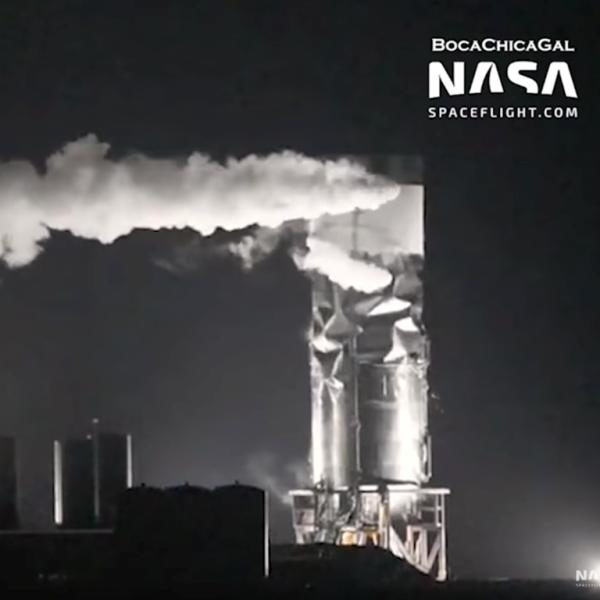
© NASA
A prototype for SpaceX's Starship space vehicle collapsed during pressure testing early Friday at the company's facility in South Texas —
the program's third failure during such testing since November — but assembly of a new version is already underway.
The stainless steel cylinder appeared to rupture near its top after filling with super-cold liquid nitrogen overnight at SpaceX's launch site at Boca Chica, Texas. Elon Musk, SpaceX's founder and CEO, tweeted early Friday that the accident may have been the result of a "test configuration mistake."
The Starship the upper stage of of SpaceX's next-generation launch and space transportation system. Coupled with a massive booster named the Super Heavy, the Starship could haul more than 100 metric tons, or 220,000 pounds, of cargo to low Earth orbit, according to SpaceX.
The fully reusable Super Heavy and Starship vehicles, which will also be able to carry people, will eventually replace the partially reusable Falcon rocket family, SpaceX says.
But testing of Starship prototypes in South Texas has not gone as quickly as Musk hoped. Last September, Musk said he wanted the Starship to reach orbit within six months. That timeframe passed last week, and no full-size Starship test craft has flown yet.
Pressure testing of the third Starship prototype, designated SN3, was completed earlier this week at ambient temperatures. The next step was to load cryogenic liquid nitrogen into the vehicle, a test that ended with Friday morning's
If the pressure testing this week had completed without incident, SpaceX teams aimed to perform a test-firing of the Starship SN3 vehicle's propulsion system as soon as next week. That would have been followed by a short hop of the Starship.
Last August, SpaceX performed a nearly 500-foot (150-meter) hop of an earlier iteration of the Starship called the Hopper.
Friday's test incident was the third time a Starship prototype has ruptured during pressure testing.
The first Starship test vehicle, dubbed the Starship Mk1, blew up during a pressure test in South Texas on Nov. 20. That vehicle was originally supposed to perform a test flight to an altitude of 65,000 feet (20 kilometers), but SpaceX said they had changed those plans and repurposed the Starship Mk1 to a ground test unit before the Nov. 20 mishap.
A modified Starship prototype named SN1 collapsed during a Feb. 28 pressure test. Musk said engineers believed that failure was with a "thrust puck" at the bottom of the vehicle that transfers loads from the vehicle's Raptor engines.
SpaceX stripped down the next Starship prototype, named SN2, to test the weld connecting the thrust puck to the vehicle. That testing was successful.
Like SN1, the SN3 prototype was built without aerodynamic fins or a nose cone, which would be included in a full-size flight vehicle.
Construction of the next Starship vehicle, named SN4, has already started in South Texas. The work is continuing amid the coronavirus pandemic, and many aerospace companies like SpaceX are continuing their work under exemptions to local and state stay-at-home orders.
Aerospace parts are considered part of the nation's critical manufacturing sector, and SpaceX is considered part of the U.S. military's industrial base. The Starship could eventually launch national security payloads.
SpaceX is also planning a Starship production facility in Los Angeles, and could launch future Starships from the Kennedy Space Center in Florida. For now, production and testing is centered in South Texas.
The company recently published its first Starship payload user's guide.
In the user's guide, SpaceX officials wrote that the Starship and Super Heavy could deliver more than 100 metric tons to low Earth orbit, and 21 metric tons (more than 46,000 pounds) to geostationary transfer orbit, the drop-off point for many commercial and military communications satellites.
With in-orbit refueling, a capability still in the nascent stages of development, the Starship could deliver more than 100 metric tons of payload to the surface of the moon or Mars, according to SpaceX.
A crew-capable configuration of the Starship could ferry up to 100 people from Earth to low Earth orbit, the moon, or Mars, SpaceX says.
"The crew configuration of Starship includes private cabins, large common areas, centralized storage, solar storm shelters and a viewing gallery," SpaceX wrote in the Starship user's guide.
Reader Comments
I ought to get her to form a F. owned company, and contract with NASA. We're rich!
He should stick to building his rolling carbecues...
R.C.
P.s., Oh, also,
"Mr. B.Bub? Mr. Bezel Bub? Please proceed to the nearest white courtesy phone, Mr. B. Bub?"
SOTT Focus:How to Create a Fake Pandemic
Greetings, fellow manipulators and deceivers, and welcome to our course on how to create a fake pandemic! As you know from our previous courses, the first thing you need for an undertaking of this...Ask for Anna24.
R.C.
And pup vids
If you breathe two lungfulls or less, you are unconscious. Two more and you're dead. Way more effective and less torturing than any other death penalty. Finally a few states, as I recall, have made it an option for death penalties. (Would have an ancillary benefit of folks on death row losing bad fact situations.
RC
But